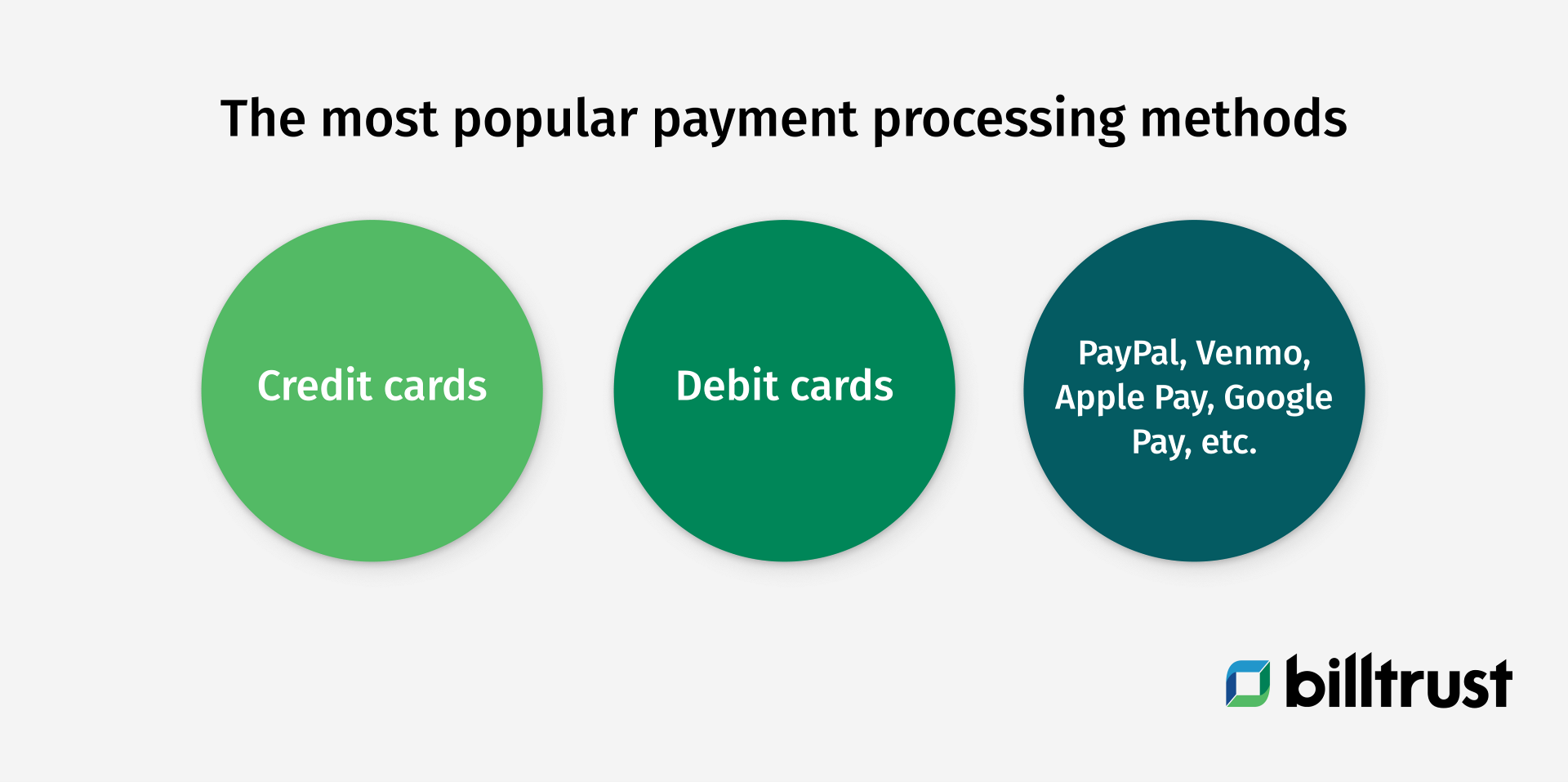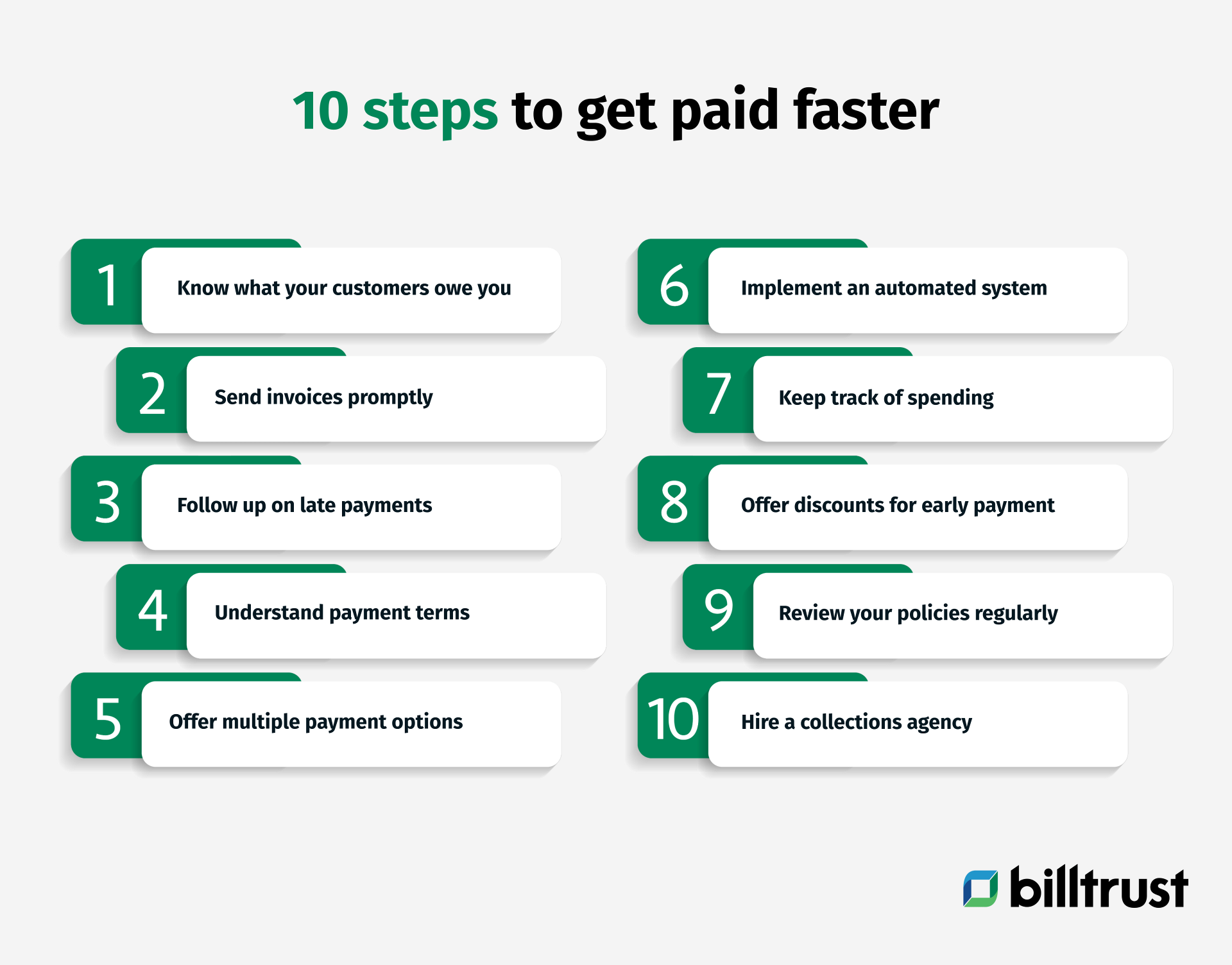Are you tired of waiting months for your clients to pay you? If so, you're not alone. Many businesses struggle with getting paid on time. However, you can do a few things to speed up the process. Below are ten pro tips to optimize payments and additional tricks to speed up your payment processing.
The most popular payment processing methods
In today's digital age, it's crucial to grasp how you can accept and optimize payments from your customers. Whether you're selling goods or services online or need a way to process payments for in-person transactions, you have a few different options.
Below, we’ll give you a quick overview of the most popular payment processing methods so you can choose the right one for your business.

Credit cards
One of the most common forms of payment is the good old-fashioned credit card. Credit cards allow customers to make purchases without carrying large amounts of cash. They also offer an added layer of protection in case of fraud or disputed charges. You’ll need to accept credit card payments to stay competitive while doing business online.
Debit cards
Debit cards are similar to credit cards because they allow customers to make purchases without cash. Still, they differ in that the funds for the purchase are taken directly from the customer's bank account. Customers sometimes prefer debit cards over credit cards because they don't accrue interest or require monthly payments. However, debit cards do not offer the same fraud protection as credit cards.
PayPal/Venmo/Apple Pay/Google Pay/etc.
In recent years, there has been a proliferation of payment processing options that allow customers to make digital payments using their smartphones or other mobile devices. Customers often prefer these options because they're quick, easy and convenient. However, all businesses may not accept them, so research is essential before deciding which one is right for you.
As you can see, various payment processing methods are available to businesses today. Each has advantages and disadvantages, so choosing the one that's right for your specific needs is essential.
The five stages of payment processing grief
If you run a business, you know that chasing payments can be frustrating. Out of all the moving parts in a company, payment processing is often the most stressful—and for a good reason. To keep the lights on and the doors open, you need cash flow, and when customers don't pay on time, it can jeopardize the health of your business.
Below, we'll look at the five stages of payment processing grief and how you can overcome them.
Download the ultimate guide to digital accounts receivable

Stage one: Denial
The first stage of grief is denial. When a customer doesn't pay their invoice on time, it's easy to convince yourself that they forgot or are going through some tough financial times and will catch up soon. However, pretending that the problem doesn't exist will only worsen it. Ignoring delinquent accounts will only give your customers more time to incur late fees and hurt your cash flow.
Stage two: Anger
After denying a problem, it's only natural to feel angry when you realize that you will not get paid anytime soon. After all, you've done everything right—you've provided a great product or service and sent out an invoice—so why shouldn't your customer pay up? It's tempting to vent your frustration directly to the customer or publicly shame them on social media but resist the urge. Getting into an argument with your customer would only worsen things, so keep things friendly.
Stage three: Bargaining
In the bargaining stage, you'll find yourself making excuses for your customer's behavior and trying to devise payment plans or discounts to incentivize them to pay their bill. While it's essential to be understanding and accommodating, you also need to be firm. If you give in too quickly, your customers will start to take advantage of you and think they can always get away with paying late.
Stage four: Depression
As time goes on and the payments still don't come in, it's easy to feel defeated and depressed. You might even begin second-guessing yourself and wondering if there's something you could have done differently. However, it's important to remember that even if this particular customer isn't paying up, other businesses value prompt payments and would love to do business with you.
Stage five: Acceptance
The final stage of grief is acceptance. You've likely tried everything you can to get the customer to pay, but nothing has worked. Now is the time to cut your losses, write off the debt as bad debt and move on. While it's never fun losing money, remember that every business has unpaid invoices from time to time—it's just part of doing business. The sooner you accept that fact, the sooner you can focus on getting paid by other customers who appreciate prompt payment processing.
The good news?
Getting paid and maintaining solid customer relations don't have to be a pain point for your business—if you know how to handle it correctly. You can optimize your payments and overcome even the most challenging payment situations with little know-how and without too much stress or drama.
To keep the lights on and the doors open, you need cash flow, and when customers don't pay on time, it can jeopardize the health of your business.
10 steps to get paid faster
Like most businesses, you're always looking for ways to optimize your payments so that you can improve and manage your cash flow. After all, what good is making a sale if you never actually see the money?
That's where enhanced payment processing comes in.
By understanding the steps involved in payment processing, you can take steps to ensure that you optimize your payments. You can get paid faster and keep your business running smoothly!
Let's take a look at the ten steps to optimize your payment processing:
- Know what your customers owe you: The first step in getting paid is knowing how much your customers owe you. This means keeping meticulous records of every sale, invoice and purchase order. Once you know what your customers owe you, it will be much easier to track down late payments and take appropriate action.
- Send invoices promptly: Sending invoices promptly is critical to getting paid on time. If your customers don't know how much they owe you, they're much less likely to prioritize paying your invoices. So make sure to send invoices as soon as the sale is made, and include all relevant information such as purchase order numbers and contact information.
- Follow up on late payments: Following up on late payments can be delicate—you don't want to come across as too demanding or aggressive, but you also need to get paid. Again, a simple phone call or email can often do the trick; make sure to document all attempts to collect payment.
- Understand payment terms: Payment terms are negotiable, so you must understand the implications of each option before agreeing to anything. For example, net 30 means the customer has 30 days to pay the invoice; however, if they don't pay within those 30 days, they may be subject to interest charges or late fees.
- Offer multiple payment options: Offering various payment options gives customers more flexibility in how they pay you, leading to quicker payments. Standard payment options include credit cards, debit cards, checks, wire transfers and ACH transfers.
- Implement an automated system: Automating your payments can help streamline the process and prevent errors. This means setting up automatic bill payments with your creditors and using software to automate bookkeeping tasks related to receivables and payables.
- Keep track of spending: In addition to tracking accounts receivables (money coming in), it's also vital to track payables (money going out). This will help you better understand your cash flow situation and avoid bouncing checks or missing payments.
- Offer discounts for early payment: Offering a discount for early payment is a great way to motivate customers to pay their invoices more promptly. For example, you might offer a 2% discount for customers who pay within ten days of receiving their invoice. Make sure you clearly state the terms of any early payment discounts upfront.
- Review your policies regularly: You should review your payment policies regularly—at least annually—to ensure they're still relevant and practical. As your business grows and changes, your policies should evolve.
- Hire a collections agency: If everything fails and you cannot collect payment from a customer directly, hiring a collection agency may be your best bet. Collections agencies specialize in collecting overdue debt, so they may succeed more than you would have on your own.

How to motivate customers to pay
As a business owner, you're always looking for ways to increase revenue and motivate customers to pay. After all, happy customers are the lifeblood of any successful business. But what's the best way to control a negotiation and get customers to pay what you're asking so that you can optimize your payments?
The answer may surprise you: by understanding their motivations.
You see, every customer is different and has their own unique set of circumstances that influence their decision-making process. However, you can use some common motivators to persuade almost any customer to pay what you're asking. Let's take a look at a few of them so that you can optimize your payments.
1. The fear of losing out.
One of the most powerful motivators is the fear of losing out on something. If you can make your customers believe they'll miss out on a great opportunity if they don't act now, you'll be more likely to get them to pay what you're asking. This is especially effective if your product or service is in high demand or only a limited supply is available.
2. The desire for status.
Another common motivator is the desire for status. People want to feel like they're part of an exclusive group or club and are willing to pay a premium price to access exclusive products and services. If you can tap into this desire, you'll be able to motivate even the most reluctant customers to pay what you're asking.
3. The need for convenience.
In today's fast-paced world, people are always looking for ways to save time and make their lives more convenient. If you can show your customers how your product or service will make their lives easier, they'll be more likely to pay what you ask. This is especially true if your product or service is unique and there's no easy way for them to get it from another source.
By understanding your customer's motivations, you'll be in a much better position to negotiate a fair price and get them to pay what you're asking. So keep these three common motivators in mind the next time you're trying to motivate a customer to pay, and you'll be sure to get the best possible price for your product or service.

How to control a negotiation
Do you feel like you're losing control during a negotiation? Maybe the other person is too demanding or unsure of what you want. Either way, it's important to remember that you are in control.
Here are four tips to help you take control of your next negotiation:
1. Know your outcome.
The first step to taking control of negotiation is knowing what you want to achieve. What is success? Answering these questions will help you keep the end goal in mind and prevent you from getting sidetracked during the negotiation process.
2. Be prepared.
Preparation is critical in any negotiation. Ensure you know all the facts and figures related to the talks before sitting at the table. The more prepared you are, the more confident you will be and the more likely you will get what you want.
3. Don't be afraid to walk away.
Don't hesitate to walk away if the negotiation isn't going your way. This doesn't mean you should give up easily, but sometimes it's better to cut your losses and move on. Remember, there is always another negotiation. You don't have to win every battle to win the war.
4. Stay calm and collected.
It can be easy to let emotions get the better of us during a negotiation, but staying calm and collected is crucial if we want to be successful. Losing your temper will only worsen the situation and make it less likely that you'll get what you want. Take a deep breath and remember that this is just a business transaction—nothing personal.
By following these four tips, you can take control of any negotiation without losing your mind in the process. Remember to know your outcome, be prepared, walk away if you must and stay calm and collected throughout the negotiation process. With these guidelines in mind, you'll always come out on top.

You can optimize payments and get paid faster
Ready to take your business finances up a notch?
Implementing even a few tactics to optimize your payments can significantly affect how quickly your invoices are processed and payments are deposited into your account.
Also, see our Related Blog Posts for more helpful advice on streamlining your operations and growing your business. And as always, if you have any questions or need help getting started, feel free to contact us – we’re happy to assist.

